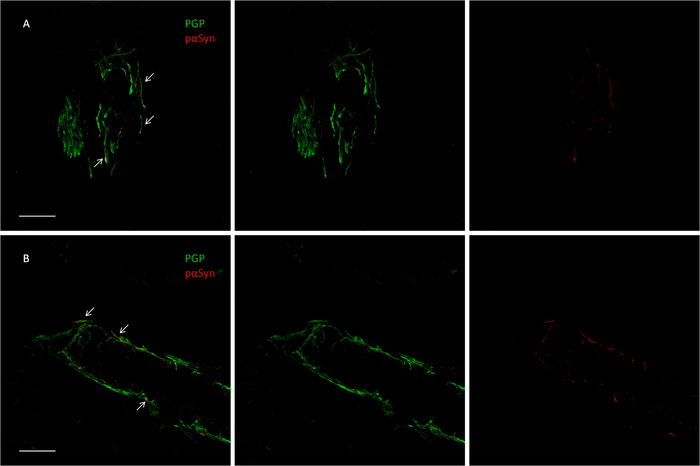Amsterdam, March 15, 2022 – The diagnosis of Parkinson’s disease (PD) is currently based on consensus clinical criteria. A novel study reported in the Journal of Parkinson’s Disease has found that the presence of neuronal deposits of the biomarker phosphorylated alpha-synuclein (p-syn) in the brain and the skin of patients with PD distinguishes them from individuals with symptoms of parkinsonism due to the accumulation of another protein, tau. This development may help the early identification and differential diagnosis of PD among the various parkinsonism subtypes.

Credit: Dr. Alex Incensi
Amsterdam, March 15, 2022 – The diagnosis of Parkinson’s disease (PD) is currently based on consensus clinical criteria. A novel study reported in the Journal of Parkinson’s Disease has found that the presence of neuronal deposits of the biomarker phosphorylated alpha-synuclein (p-syn) in the brain and the skin of patients with PD distinguishes them from individuals with symptoms of parkinsonism due to the accumulation of another protein, tau. This development may help the early identification and differential diagnosis of PD among the various parkinsonism subtypes.
The main parkinsonian symptoms are shared with other synucleinopathies, as well as with atypical parkinsonism, including progressive supranuclear palsy (PSP) and corticobasal syndrome (CBS), both of which are due to the accumulation of another protein, tau. Despite the clinical overlap with PD, PSP is characterized by 4-repeat tau deposits, mainly in the basal ganglia, brainstem, and cerebellum, and CBS is a clinical syndrome with a heterogeneous underlying neuropathology, represented mainly by tauopathies but also by synucleinopathies.
“Research in PD and other neurodegenerative disorders is to find treatments able to halt and ideally prevent the accumulation the pathological proteins responsible for the different disorders. Our lab, led by Prof. Rocco Liguori and Dr. Vincenzo Donadio, has spent the last decade looking for reliable biomarkers of PD and related disorders to achieve an accurate and early diagnosis,” explained corresponding author Maria Pia Giannoccaro, PhD, Department of Biomedical and Neuromotor Sciences, University of Bologna and IRCCS Istituto delle Scienze Neurologiche di Bologna, Bologna, Italy.
“This research sprang from the same effort. Our aim was to see if we could distinguish PD from two potential mimics, PSP and CBS, and to explore the potential for using this approach to support clinical diagnosis,” Dr. Giannoccaro continued.
Investigators recruited 26 patients with PD, 26 patients with either PSP (18) or CBS (8), and 26 healthy individuals from May 2014 to April 2017. All individuals underwent skin biopsy in three sites, the leg, the thigh, and the cervical area, to study p-syn deposits in skin nerves. They found that all except two of the PSP/CBS patients had no skin p-syn deposits, as well as all the healthy individuals. Conversely, all PD patients showed p-syn deposition.
The investigators were surprised by the finding that two patients diagnosed with PSP and CBS, respectively, had p-syn skin deposits. One possibility is that these two patients were misdiagnosed, however, the diagnosis was confirmed by clinical and MRI findings. Another intriguing possibility is that some patients have a mixed pathology with multiple neurodegenerative disorders occurring at the same time. Both patients had some atypical features more typical of PD that could suggest an atypical synucleinopathy presentation.
“To our knowledge this is the largest study comparing in vivo the peripheral deposition of misfolded alpha-synuclein in PD and PSP/CBS cases,” commented Dr. Giannoccaro. “We showed that the presence of skin p-syn deposits accurately distinguishes patients with PD from those with atypical parkinsonism. Early differentiation and accurate in vivo diagnosis are important for adequate clinical management and patient care since the treatment and prognosis of PD, PSP and CBS are different.
The investigators recommend further studies including larger samples of patients to confirm these results. Moreover, in the near future, it could be relevant for the recruitment of patients in clinical trials of potential disease-modifying therapies.
PD is a slowly progressive disorder that affects movement, muscle control, and balance. It is the second most common age-related neurodegenerative disorder affecting about 3% of the population by the age of 65 and up to 5% of individuals over 85 years of age.
DOI
10.3233/JPD-212904
Method of Research
Experimental study
Subject of Research
People
Article Title
Presence of Skin α -Synuclein Deposits Discriminates Parkinson’s Disease from Progressive Supranuclear Palsy and Corticobasal Syndrome
Article Publication Date
15-Feb-2022




